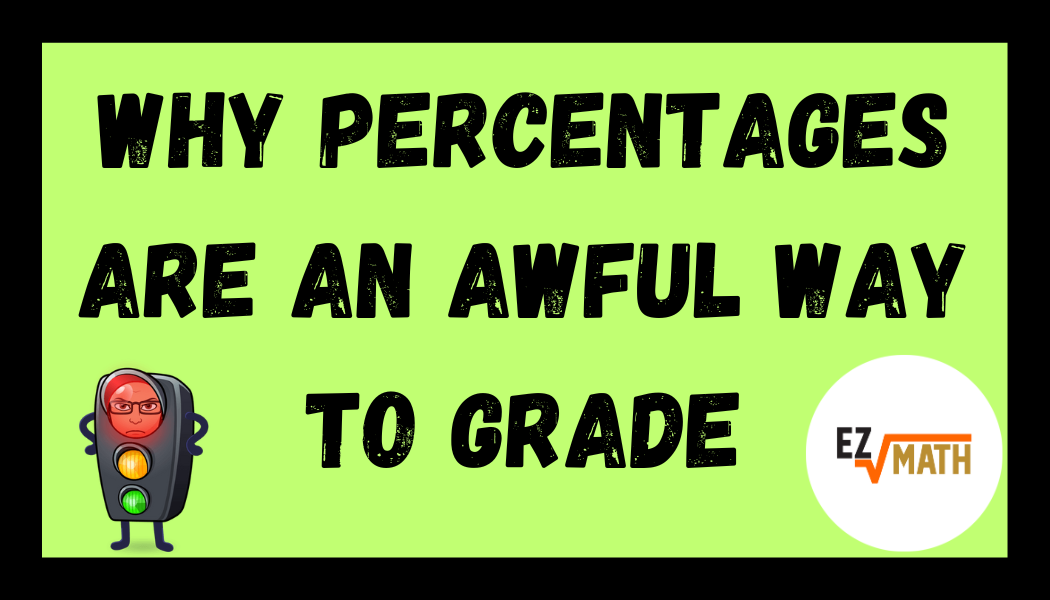You are back in middle school. Your haircut is phenomenal, your clothing choice is the height of modern fashion, and you just finished eating lunch with your friend group that is heavily skewed towards your own gender. (If you are being honest with yourself, only one of those statements is actually true). You head to math class and hunker down in your assigned seat. The bell rings, attendance is taken, and the teacher begins handing back your test from the previous week.
Close your eyes and imagine what the test looks like. How is it graded? What kind of marks are written on it? Is there a letter grade written at the top like the common Hollywood trope? Maybe a percentage? Perhaps there is a fraction that shows how many points you earned out of how many there were possible?
More important than that, how do you feel? What thoughts and emotions are running through your brain? Are you excited? Proud? Disappointed? Angry?
When you get the test back, do your thoughts immediately head towards beating yourself up for what you did wrong, or do you celebrate over what you knew how to do? I’m willing to bet it’s the former over the latter.
One of my biggest fears as a middle school math teacher is that I have contributed to the feelings of self-loathing and shame for thousands of children over the years because of the way I have graded exams. I have worked so hard over my career to teach with kindness and empathy. I try to be strict but fair with my students, and clear with my expectations. My goal is to make sure that every student knows they are valued, are important, and that they can learn math at a high level. No matter how hard I try, though, I cannot erase the probable trauma that I have caused because of the traditional grading system I used for so many years.
As teachers we want to give feedback to our students they can use to develop their skills; Here is where you are, and here is what you need to work on to reach your goal. Seems simple enough. The problem is that providing this feedback to 150 students on a regular basis for one human being is virtually impossible. How do I find the time to give meaningful feedback to every student for every single Target or learning outcome they are expected to master in a single school year? For example, the Enhanced Math 1 course I teach has 37 different learning targets for the year. It’s…a lot.
I think this is why education developed the letter-grade percentage based system in the first place. It really has that industrialized one-size-fits-all assembly line kind of feel to it, which makes sense since the first record of letter grades comes from the late 1800’s. Got a few hundred students to assess? Give them all the same test, assign points to each question, then assign them a grade based on their percentage. Seems simple, right?
There are so many problems with percentages, but for today I will just focus on one. A percentage doesn’t tell you what you know, and what you don’t know. I mean, it kind of does, but not really. The best example I have for this was presented by Cassandra Erkins at a district training I attended quite a few years ago.
Suppose you have three students take a test that covers 5 different skills. Let’s say there are 10 questions for each skill. Each student gets an 80%. Which student has mastered the content, which student needs a bit of support, and which student needs an intervention?
Impossible to know, right?
What if you looked at the test and saw how they did on each individual skill? Here’s the results by skill instead:



Which student gets the intervention time? Who has a pretty good grasp of all the concepts? Who needs a little bit more support?
It seems clear to me that Student #1 needs the most support, since they did not know how to do skill #5 at all. Student #2 has a pretty solid grasp on all of the skills, and Student #3 needs some additional support on skills 2 and 3. All of the students got an 80% on the test, but two of the three need more help. Unless you focus on the actual Targets, you might just say “80% is good enough” and 2 out of three students would not get the help they need.
Also, who’s to say that 80% is a good score anyway? I mean, it’s great for a hockey player’s shooting percentage, but it’s pretty terrible if it’s a surgeon’s mortality rate. Percentages are super subjective and don’t really tell you the whole story. So why do teachers use them?
Well, it’s easy, that’s why. It’s really easy to assign points to each question, grade them right or wrong, then give an overall percentage score. If you use an overall score, you never need to do the work of digging into the results and finding the Student #1’s in the class.
While overlooking student misconceptions is one harmful byproduct of using percentages to grade students, I would argue that the more harmful practice is that of students seeing themselves as that percentage. I’ve witnessed it a thousand times. Hand back a test to a student and the first thing they look for is the score. If it isn’t 100%, the next thing they look for is what they got wrong. Then they get mad at themselves for getting those things wrong. The phrases “I’m so stupid” and “Why did I do that” start flying around the room. Then students start arguing with you for more points in a desperate attempt to raise their grade. It’s a disturbingly toxic cycle I have seen happen over and over again. Instead of celebrating all of the things they knew how to do, they focus only on what they didn’t. What should be a moment of joyful learning inevitably becomes an anger and shame spiral.
So now I use Standards Based Grading in my classroom. I don’t give points or percentages. Students are assessed on specific Targets and are given feedback via a 4-point rubric that shows what they know, and what they still need to work on. When using the rubric I focus on the student’s overall understanding of the Target, and I don’t worry about small formatting mistakes. When I give back the assessment I always begin by having them celebrate what they are proud of. I listen closely for any student starting down the shame spiral and I try to intervene by highlighting what they did well.
Is it a perfect system? Of course not. I don’t believe that one of those could ever exist. Is it better than what I used to do? Absolutely. The work is hard and time consuming, but the learning outcomes and mental health of my students is worth the time and effort. No child should ever reduce themselves to a numerical score, and I never want to contribute to that kind of thinking ever again.
I plan on writing in more detail about how our school has implemented Standards Based Grading in the future. If you would like more information on the practice, here are some of the best resources I have used:
A Teacher’s Guide To Standards Based Learning

